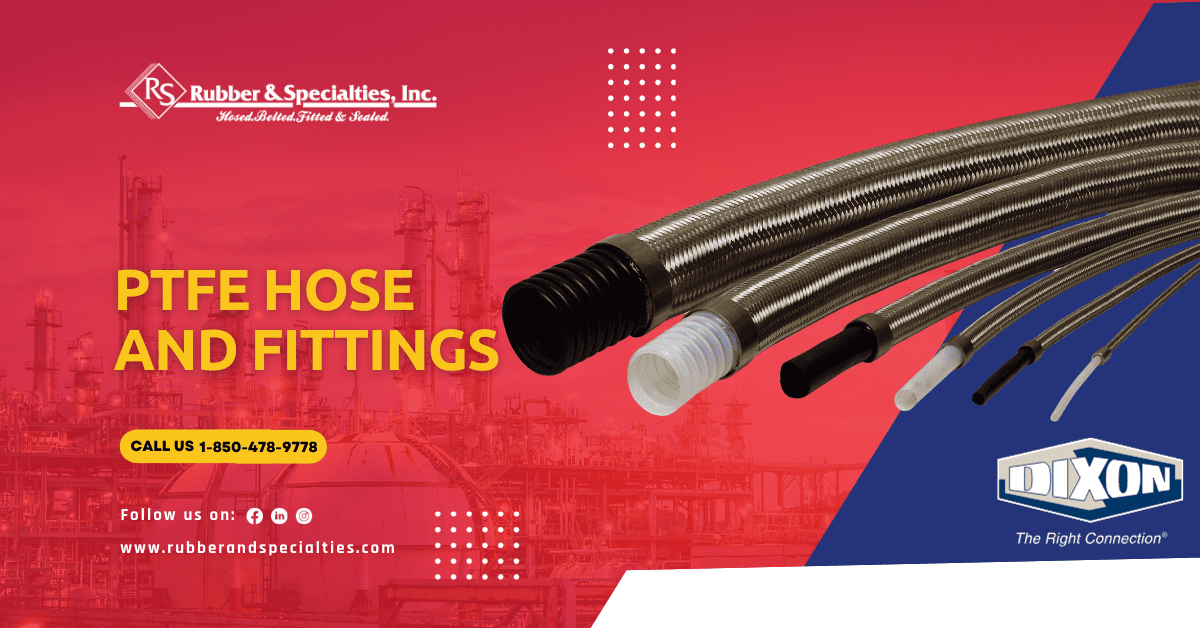
PTFE Hose and Fittings
What do non-stick cookware, the atomic bomb, and hoses have in common? They all utilize PTFE. But what exactly is PTFE and why is it used? Keep reading to learn more.
What is PTFE?
Polytetrafluoroethylene, known as PTFE, is a type of plastic first discovered by chemist Roy J. Plunkett. The discovery of PTFE happened by accident as a by-product of an experiment intended to manufacture something else. PTFE was patented by DuPont in 1941. The plastic held the record for the lowest known dynamic and static coefficient, making it the slickest substance on Earth. After more experimentation, it was determined that the uses of PTFE were unlimited. Once manufacturing began it was commercially trademarked as Teflon®.
PTFE Applications
PTFE was used in the Manhattan Project in 1942 to create the first atomic bomb. The PTFE held and transported the highly corrosive uranium hexafluoride, which was fuel for the nuclear weapon. Within 20 years, PTFE was found on non-stick cookware, aeronautic components for outer space, and waterproofing for clothing.
PTFE is used in a variety of applications including the automotive, chemical, electrical, and medical industries. PTFE hoses are used for bleach and chlorine, bromine, steam, acid, compressed natural gas (CNG), natural gas, ethanol, transmission fluid, brake fluid, antifreeze, oil transfer, pump hoses and pump connectors, solvent and paint, alcohol, and pharmaceutical hoses.
PTFE Lined vs. Metal Hose
Choosing to use PTFE-lined hose or metal hose depends on the application. PTFE-lined hose is lightweight, chemically resistant, and cost-effective. It boasts a nearly unlimited shelf life, high-pressure rating, and can withstand temperatures from -100°F to 450°F (-73°C to 232°C).
Metal hose is also lightweight, but heavier than PTFE hose. The metal convoluted liner offers limited chemical resistance, and a good pressure rating, and can be used in high-temperature applications.
GSM Armor on PTFE Hose
GSM armor is available on PTFE hose. GSM armor is a unique half-round ball-joint armor applied externally after fire insulation is installed on the hose. Two pieces of half-round wire are wrapped tightly down the length of the hose and secured at each end with a crimp collar. The two half-wire construction of the armor allows the hose to have exceptional flexibility with no restrictions to the bend radius or axial movement. There are many applications where GSM armor hose can provide a solution, including operations with high heat, molten slag, abrasion, or loose objects falling on a hose. Dixon first developed GSM armor hose for use in the steel industry. Read our blog post, A History and Overview of GSM Armored Hose, to learn more.
Smooth Bore vs. Convoluted PTFE Hose
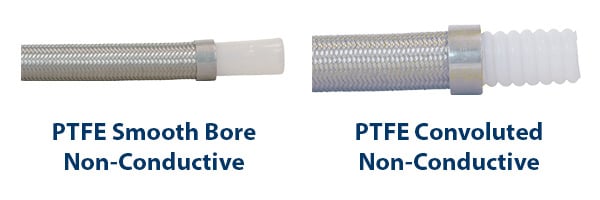
There are different types of PTFE hose, including smooth bore and convoluted. Smooth bore PTFE hose has a higher working pressure than convoluted PTFE hose. Smooth bore is a more rigid hose with limited flexibility, but it drains better, offers better flow, and is FDA-approved. Conversely, convoluted PTFE hose has better flexibility compared to smooth bore PTFE hose, along with being a lighter hose and having a longer life expectancy.
Conductive vs. Non-Conductive PTFE Hose
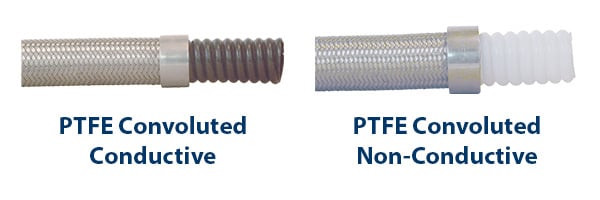
Other types of PTFE hose are conductive and non-conductive. Conductive PTFE hose is available as both smooth bore and convoluted hose. The hose is black due to the carbon coating that dissipates static. The type of media being transferred determines if there is a need for a conductive PTFE hose. Some examples include fuels, flammables, gas, and electrical applications.
Non-conductive PTFE hose is white and also available as smooth bore and convoluted hose. Non-conductive PTFE hose will not carry an electric charge.
Nominal Bore vs. True I.D. PTFE Hose
The last two types of PTFE hose we will compare are nominal bore and true I.D. Nominal bore PTFE hose is available as smooth bore only with male and female ends. The ends can be swivel or tube ends at 45° and 90° angles. Brass fittings are available upon request.
In contrast, a true I.D. hose, also called a true bore, is available as both a smooth bore and a convoluted hose and has a heavier wall than the nominal bore. Like nominal bore, true I.D. PTFE hose comes with swivel and tube male and female ends. In addition, 316L stainless steel ends are available for clean-in-place (CIP) systems, which are commonly used in food, chemical, and cosmetic plants.
Dixon’s PTFE Offering
Dixon is delighted to provide a wide range of PTFE hose and fittings to meet your needs.
Nominal Hose
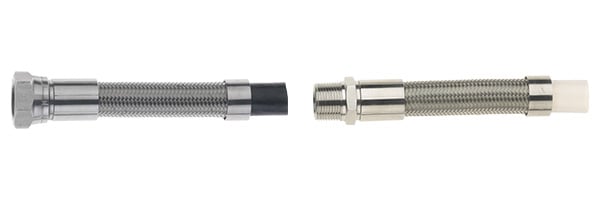
Application:
- Suitable for conveying chemicals, food, pharmaceuticals, oil, gas, fuels, and steam
Size:
- Ranges from dash-3 to dash-20
Features:
- 304 stainless braided
- Extruded or heat shrink coverings are available upon request
- Boxed coils (bulk, per ft. lengths, and full reels available)
- For use with nominal PTFE fittings
Specification:
- Temperature range: -100°F to 450°F (-73°C to 232°C)
Approval:
- Nominal standard smooth bore PTFE hose meets SAE100R14
Dixon Product Offering:
Nominal Smooth Bore PTFE Hose Non-Conductive
Nominal Smooth Bore PTFE Hose Conductive
Nominal PTFE Fittings
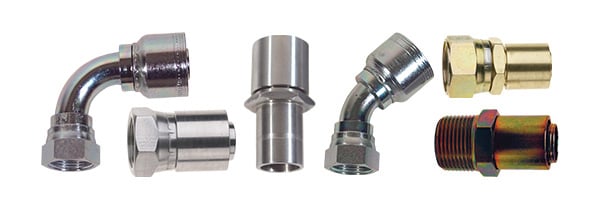
Application:
- For use with nominal smooth bore PTFE hoses
Dixon Product Offering:
Female JIC Swivels
Rigid Male Pipe Fittings
Female SAE Swivels
Tube End Stubs
45° FJIC Fittings
90° FJIC Fittings
True I.D. Hose
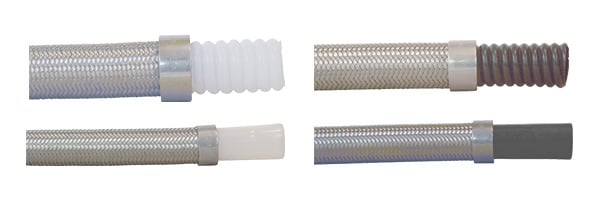
Application:
- Suitable for conveying acids, chemicals, foods, and pharmaceuticals
Size:
- 1/4″ to 2″
Features:
- Boxed coils (bulk, per ft. lengths, and full reels available)
- 304 stainless braided
- Other braids including synthetic, extruded, and heat shrink coverings are available upon request
Dixon Product Offering:
True I.D. Open Pitch Convoluted Hose Non-conductive
True I.D. Open Pitch Convoluted Hose Conductive
True I.D. Heavy Wall Smooth Bore Hose Non-Conductive
True I.D. Fittings

Application:
- For use with true I.D. PTFE hoses
Dixon Product Offering:
Female JIC Swivels
Rigid Male Pipe Fittings
Sanitary Tri-Clamps
Mini Sanitary Tri-Clamps
Flange Retainers
Convoluted Crimp Collars
Smooth Bore Crimp Collars
Dixon’s PTFE hoses come standard, insulated, and armored, covered in fire sleeves, or wrapped in heat-shrink covering. Different testing services are available for PTFE hose, as well.
Flare Through Fittings
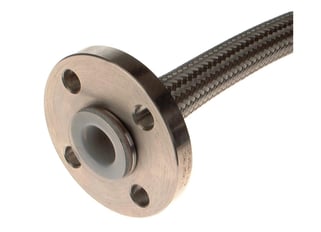
With flare-through fittings, the PTFE hose comes through the fitting so the product running through the assembly touches nothing but PTFE. This is helpful when dealing with chemicals that may cause damage to metals like stainless steel. Flare-through fittings are widely used in the food, beverage, dairy, cosmetic, and pharmaceutical industries. The PTFE tube is convoluted, giving the hose an extremely tight bend radius as well as being resistant to steam and virtually all chemicals and solvents used in the industries mentioned. Due to the inherent qualities of PTFE and the manner of construction, Dixon’s flare through PTFE is essentially self-draining and very easy to clean.
Hose Insertion Tool and Dies
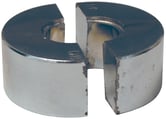
If you are assembling your own PTFE hoses, Dixon offers a hose insertion tool and dies that take the hassle out of installing crimp collars onto braided PTFE hose. With a few simple steps, even a challenging braid can be easily and safely inserted into the crimp collar.
SOURCE: PTFE Hose and Fittings

